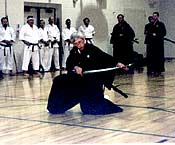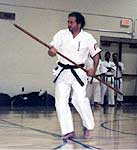Bushido Taikai Report
by Deborah Klens-Bigman, Ph.D.
Editor’s Note: Cooperation and sharing
of knowledge between various martial arts disciplines is a great educational
opportunity, one that spurs interest and broadens the knowledge and appreciation
of other arts. A taikia, or gathering of various schools of martial arts,
is one of the best vehicles through which participants can experience
other discipline through exhibitions, workshops and seminars. FightingArts.com
hopes this report will prompt others to participate or organize similar
events.
May 5th is Boys' Day, a traditional holiday in Japan. This auspicious
date was also the day of the 5th Annual Bushido Taikai, held in East Lansing,
Michigan.(1) The event was sponsored by
Shakunage Consulting, Inc., an organization devoted to promoting Japanese
culture in the U.S. and abroad, and The United States Tamiya ryu Iaijutsu
Michigan Dojo. Martial arts dojo from around the East Lansing area were
invited to participate in a day of demonstrations, "mini-courses"
and fellowship. In addition to area participants, I was invited to attend
as a special guest from New York Budokai. The Taikai took place at the
newly renovated Hannah Community Center in East Lansing.
The day began with an enbu (exhibition), with demonstrations by each
participating dojo, followed by a brief lunch. In the afternoon the teachers
were invited to give two short workshops, each one hour long, in their
respective disciplines. Participants could be members of the various dojo
or members of the general public. The idea was that everyone could take
the opportunity to explore the rudiments of the different styles. There
was no admission charge for the enbu, but mini-course participants were
asked to pay $5.00 per hour to help offset the cost of renting the gymnasium.
 After
a brief opening ceremony, Michael Alexanian Sensei and his students from
the U.S. Tamiya ryu Iaijutsu Michigan Dojo led off the enbu. Tamiya ryu
is a very old form of Japanese swordsmanship which can trace its lineage
back to the end of the 16th century. Besides technique, the study of Tamiya
ryu involves learning the Code of Bushido with regard to character: right
decision, bravery, compassion, right action, sincerity, honor, and loyalty.
Since my style of iaido, Muso Shinden ryu, is descended from Tamiya ryu,
it is always a treat to see these kata performed. After
a brief opening ceremony, Michael Alexanian Sensei and his students from
the U.S. Tamiya ryu Iaijutsu Michigan Dojo led off the enbu. Tamiya ryu
is a very old form of Japanese swordsmanship which can trace its lineage
back to the end of the 16th century. Besides technique, the study of Tamiya
ryu involves learning the Code of Bushido with regard to character: right
decision, bravery, compassion, right action, sincerity, honor, and loyalty.
Since my style of iaido, Muso Shinden ryu, is descended from Tamiya ryu,
it is always a treat to see these kata performed.
Next, we were treated to a demonstration by the Original Okinawa Karate
Dojo, led by Seikichi Iha Hanshi, 10th dan, and assisted by Nakasone Sensei,
8th dan. This group teaches the Shido-kan style of Okinawan Shorin ryu
Karate-do. The dojo is also the headquarters of the Beikoku (North American)
Shido-kan Association. Iha Sensei brought a large group of students and
showed a comprehensive overview of their curriculum, including kata and
bunkai for various techniques. Nakasone Sensei then proceeded to break
long one-by-three planks across the legs and arms of some of the students
to show their toughness. This was definitely the crowd-pleasing highlight
of the demo. The loudly cracking boards and flying splinters produced
ample applause.
| The Okinawan Karate-Do Club of Jackson,
MI followed with a demonstration of Okinawan Kobudo Weapons forms.
Chief Instructor Lee Norton explained how open-hand forms related
to kobudo weapon forms, including the use of tsai and bo. The group
also showed partner forms pitting different weapons against each
other. |
 |
Next, Jerome Helton Sensei led a group of students from the Michigan
State University Aikido Club in showing techniques and philosophy of Yoshokai
Aikido. Helton Sensei did an excellent job of explaining various principles
of harmony and utilizing the opponent's energy as a means to self-defense,
illustrating them with aikido techniques, including aikiken (aikido sword
techniques).
A kendo demonstration followed by Ron Fox Sensei of the MSU Kendo Club.
Fox Sensei and one of his students showed some kendo no kata (formal partner
techniques), followed by a brief demonstration of shiai, sparring in full
kendo gear with bamboo shinai.
Last, but hopefully not least, I demonstrated some iaido techniques intended
to outline the curriculum of New York Budokai. I showed forms from the
Shoden, Chuden and Okuden levels of Muso Shinden ryu; then threw in a
few from the Tenshinsho Jigen ryu style of iaido as well. Since I was
alone, I was unable to show any kumidachi (partner techniques) which are
also part of the curriculum. Maybe next year.
My demonstration ended both the morning and the enbu part of the Taikai.
We were able to adjourn to the Shakunage Gardens and Culture Center for
a brief but excellent lunch of zaru soba (cold buckwheat noodles) expertly
created by Dianne Contos Alexanian, who also happens to be President of
Shakunage Consulting.
In the afternoon, audience and dojo members were able to take part in
mini-courses in Tamiya ryu iaijutsu, Okinawan Kobudo weapons forms, and
Muso Shinden ryu iaido. Though each course was one hour, some participants
elected to stay with the same art form for both sessions, while others
circulated. This created a challenge for teachers who were not only introducing
their art forms but trying to keep them interesting for the participants
who stayed all afternoon.
The obvious question, of course, is what can be of interest to students
who are trying out an art form for only a couple of hours, when it actually
takes years to learn? Each teacher had his or her own approach. For my
part, I tried to explain certain principles that apply broadly across
disciplines, such as the use of koshi (hips/lower back) and in-yo (yin-yang),
relate to the specific sword techniques that we teach. While it is extremely
difficult to carry away specifics of an art form in such a short time,
I think we were all hoping to impart a sense of shared interest to each
other. Rather than the competitive spirit that exists at some taikai,
the 5th Annual Bushido Taikai is designed to enhance understanding and
cooperation. I hope I took some part in accomplishing that; and I hope
to be able to participate again next year.
Footnote:
(1) The 2002 Bushido Taikai Participating
Dojo were:
Karate
Iha Dojo (517) 482-3217
Shido-Kan Okinawan Karate
Iha Seikichi, Sensei
2018 East Michigan Ave.
Lansing, MI 48912
www.ihadojo.com
Okinawan Karate-do Club of Jackson (517) 768-1110
Okinawan Kobudo Weapons
Lee Norton, Sensei
137 ½ East Michigan Ave., 2nd Floor
Jackson, MI 49201
Kendo
MSU Kendo Club (517) 355-9672 Ext. 349
Ron Fox, Sensei
166A Cyclotron
Fox@msu.edu
www.msu.edu/~foxr/
Aikido
MSU Aikido Club (517) 393-3490
Ysohokai Aikido
C/O Shawn Twomey, Sensei
2924 Trapper’s Cove Trail #2b
Lansing, MI 48901
Iaido/Iaijutsu
United States Tamiya Ryu Iaijutsu (517) 332-3221
Michigan Dojo
Michael (Gennan) Alexanian, Sensei
838 Stuart Ave.
East Lansing, MI 48823
Info@Shakunage.org
www.shakunage.org/page.cfm
New York Budokai (212) 369-5797
Muso Shinden Ryu Iaido
Tenshoshin Jigen Ryu
Deborah Klens-Bigman, Sensei
info@newyorkbudokai.net
www.newyorkbudokai.net
About The Author:
Deborah Klens-Bigman is Manager and Associate Instructor of iaido at
New York Budokai in New York City. She has also studied, to varying
extents, kendo, jodo (short staff), kyudo (archery) and naginata (halberd).
She received her Ph.D in 1995 from New York University's Department
of Performance Studies where she wrote her dissertation on Japanese
classical dance (Nihon Buyo). and she continues to study Nihon Buyo
with Fujima Nishiki at the Ichifuji-kai Dance Association. Her article
on the application of performance theory to Japanese martial arts appeared
in the Journal of Asian Martial Arts in the summer of 1999. She is married
to artist Vernon Bigman. For FightingArts.com she is Associate Editor
for Japanese Culture/Sword Arts.
|